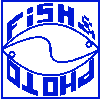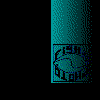












This
month the theme is Labyrinthfishes. They are called so because they have at their
disposal an organ resembling a labyrinth. That enables them to live under circumstances
with a very low level of oxygen. Therefore they are able to take up atmospheric
air at the surface of the water and use it by way of the labyrinth organ as a
kind of assesive (additive) breath
The
Choclate-goerami
Sphaerichthys osphromenoides osphromenoides Canestrini,
1860
Sphaerichthys osphromenoides male
Perhaps
it is the most interesting representative from this group of fishes. Therefore
there are two point at a set of three reasons: They posses a not every day colour
pattern for fishes and combine it with a very interesting way of reproduction;
the mouth breeding. The third reason is that from their introduction in 1860,
as they were described by Mr. Canestrini, just concerning that reproduction continued
to de nevelen bleven hullen until half away the seventy's. At that moment the
first massages of reproduction came out in dribs and drabs.
Before they were
considered problematic fishes at wich the reproduction was a difficulty. So several
stories were told, at which one couldn't escape from the impression that the authors
zealously parrot each other. Story's here and there emerged that they were livebearers
or builders of a foam nest. And when little by little began to appear that they
were mouthbreeders one tried to camouflage the blunder by the new fantasies of
two reproduction methods: of foam nest builders in environment with calm water
and mouth breeding in waters more turbulent. This last theory never has been abandoned
for 100%, although nobody believes it seriously any more.
A second problem
that had to be cleared was the sex determination. All described methods appeared
not to be conclusive until one experienced that a number of the differences could
be brought back to the region the fishes derived from. But with all the subspecies
the male has a clear light edge at the dorsal and the anal fin as well. The ends
of these both fins are clearly pointed. At the mating time the females can be
distinguished clear at the belly region more rounded.

The
pictures above show, at clockwise direction, a clear impression of the course
of the mating. Who wants to read more can follow the links on this page or consult
the bibliography.
Both articles of Frans Maas can be read integrally on this
website soon.
Linke,H.; Labyrintfische; Farbe
im Aquarium Tetra Verlag 1998
Maas, Frans;Succesvolle kweek met Sphaerichthys
osphromenoides. Het aquarium; jaarg.46 blz. 128 e.v.
Maas, Frans; Oude liefde
roest niet. Het Aquarium; jaarg.62 blz 241 e,v.
Richter, H.J. ; Labyrintfische,
H.J.W. Becht Amsterdam 1984

Labyrinth organ